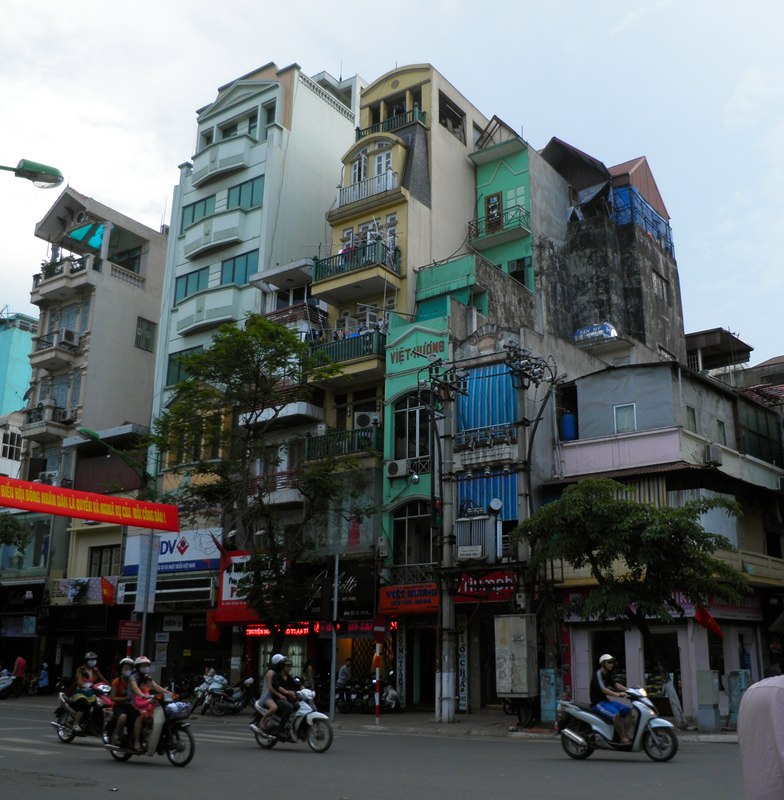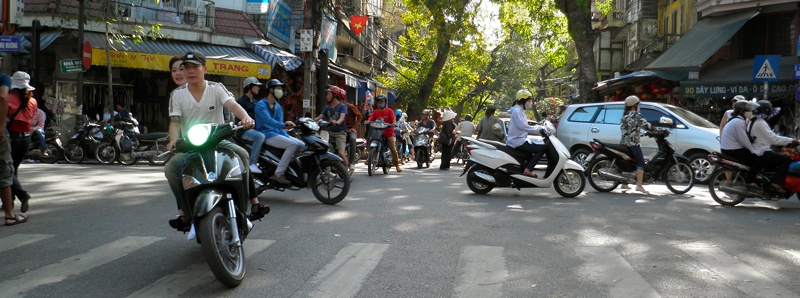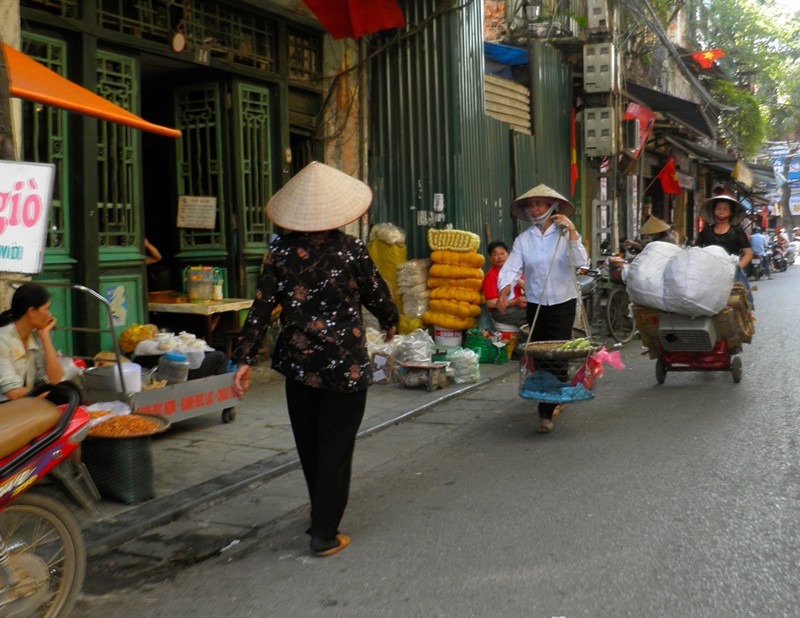Hello Vietnam! - Hanoi, Vietnam

Harmonie
Don and Anne Myers
Sat 14 May 2011 02:13
|
21:02.187N 105:50.830E
April 26, 2011 - April 27, 2011
We left the boat at Rebak Marina as planned on April 26th and
after one ferry ride, a taxi ride, three flights (Langkawi - Kuala Lumpur -
Ho Chi Minh City - Hanoi) and a second taxi ride, we arrived at the aptly
named Charming II Hotel in the old quarter of Hanoi, Vietnam. Yes, that
Hanoi, in north Vietnam. We chose to visit the north
of Vietnam instead of the south for two reasons. First, travel
planning procrastination on my part led to timing that wouldn't be the greatest
for south Vietnam (late April/early May is the start of the rainy season there,
and we were hoping to escape high heat and humidity, not endure more).
Second, most of our friends who visited Vietnam before us said the
north tended to be more interesting and less developed than the south,
all of which sounded good to us.
So about Vietnam...
Everyone is familiar with Vietnam - mostly based on
memories of the '60's and '70's and the movies that came later - but
if you're like us, we found we didn't know much about post-war Vietnam.
Some reading and a few days of first-hand experience changed that a little
bit. Here's a four-sentence summary: After what the Vietnamese call
the American War, the Vietnamese people toughed out an extremely
grueling two decades of severe poverty (70% of the population below the
poverty line). This was caused by rigid and sometimes corrupt
government, several bad harvests, soaring inflation (as high as 775%), and
an economy heavily crippled by sanctions levied by western countries, and
later, the collapse of communism in the USSR (which ended financial
support for Vietnam). In the late 1980's things started to look up
with a change in Vietnamese leadership, and by the mid-1990's the US trade
embargo was lifted and full diplomatic relations were restored between the US
and Vietnam in 1995. At that point, western cash started to flow into
Vietnam, tourism began to take off and capitalism was allowed to creep in
to some markets. As they say, the rest is history, and suddenly there
we were, smiling in a sea of north Vietnamese people on April 30, 2011, the
day the 'Liberation of Saigon' is celebrated. Of course we remember
that day in 1975 a little differently (helicopters frantically ferrying the last
Americans off the US embassy's roof and all), but today in
Vietnam, Liberation Day is paired with Labor Day and celebrated
nationwide over a long weekend. The Vietnamese are incredibly
resilient. They prefer to look forward rather than back, and as a result,
the fact that two Americans were in their midst on Liberation Day didn't seem to
bother them in the least. More to come on our Liberation Day
experience in the next blog entry.
Moving on to Hanoi...
Our introduction to Hanoi consisted of a twenty minute
taxi ride from the airport to the heart of the old quarter in the
dark. We were braced for crazy traffic based on forewarnings
from friends, but what we saw was more intriguing than crazy. The
city is not well lit. For a city its size (6.3 million), there is very
little street lighting and few high rise buildings to create that
nighttime city glow usually seen when approaching a large city after
dark. In fact, the skyline is entirely odd. Hanoi is a city built on
a foundation of market stalls. Market stalls measuring 4 meters (~12 feet)
wide, to be exact. Over time, these market stalls turned into shops, then
shops with apartments above, then shops with more apartments above.
All built on a 4 meter wide by 13 meter long base. The resulting
awkwardly tall and abnormally skinny buildings are called tube houses.
The height of each tube house is consistently inconsistent with its
neighbors, making the Hanoi skyline look more like a
semi-toothless grin than the usual shining mass of steel and glass.
Not an ugly skyline, just intriguing - like the traffic. Speaking
of traffic... our introductory taxi ride wasn't scary, but we did notice an
inordinate amount of horn tooting. Not necessarily angry get-out-of-my-way
horn blasting, more like here-I-am-make-room-for-me horn tooting. Our
first taxi driver was a very liberal horn-tooting guy. If we cared enough
to count the horn toots from the airport to the hotel, there may have been as
many as eighty.
As we approached the city, and the old quarter in particular,
we started to get an appreciation for the warnings received from friends.
There are no stop signs. No yield signs. No traffic lights. No
attempt at traffic control whatsoever. Each intersection is a free for
all. However, no one speeds, and from a distance, you could almost say the
movement through the intersection is semi-civilized - a meeting of
motorists (and bicyclists) rotating, weaving and horn-tooting through. The
advantage of this type of non-traffic control is there is no need for traffic to
stop. In a way, it's very satisfying. Imagine driving through the
streets and avenues of New York City never having to stop. Of course,
overall you would have to drive more slowly, be more polite to other
drivers, and employ an inordinate amount of horn tooting, but still, the nonstop
thing is attractive don't you think? As much as the non-traffic control
seems to work for buses, trucks, cars, motorcycles, scooters, bicycles and
cyclos (sort of a backwards tricycle with a chair in front for tourists and a
bicycle seat in back for the cyclo peddler), it leaves much to be desired for
the pedestrian - especially the tourist pedestrian. Crossing a street at
an intersection in Hanoi's old quarter is, let's say, interesting. We
followed the advice of friends and chose carefully when to start crossing, and
once started, never hesitated, stopped, or even looked at oncoming
traffic. The trucks, buses, cars, motorcycles, scooters, bicycles and
cyclos wove around us, occasionally giving us a quick horn toot to ensure we
were paying attention. We employed this street crossing method throughout
our stay in Hanoi and obviously have lived to tell about it. By the end of
our visit, we developed an extremely high level of respect for the drivers
of Hanoi. Anyone that can safely operate a motorcycle through a
free for all intersection dodging inexperienced tourist pedestrians while
transporting a family of four (wife and two kids), carrying the day's
groceries, and chatting on a cell phone deserves a little
respect.
When we arrived at the Charming II Hotel, which is a
converted eight storey tube house, we had to look closely to see a
hotel really existed there. The Charming II tube house is on a
corner where the front door is a mere two feet from the street, but the
narrow street frontage (you guessed it, 4 meters) made it really easy to
overlook. Once whisked inside, three staff members immediately took care
of everything and fifteen minutes later we were standing on the street corner
again blinking at an old quarter street map in the semi-darkness, trying to
determine the best route to the recommended restaurant for dinner (it was only 1
1/2 blocks away). After successfully completing our first street crossing,
we found it was impossible to walk on the sidewalk. Hanoi, and especially
the old quarter, is a street city. Everything spills out onto the
sidewalks and creeps into the street. For tube house residents, the
sidewalk is a combination kitchen, dining room, living room, backyard and garage
all rolled into one. Meals are prepared and eaten on the
sidewalk (while sitting on low plastic stools), it's also the evening
hang-out spot, and where the family motorcycle is parked at night. In
the evening, you can't walk down the sidewalk without feeling like you're
invading someone's home. We finally made like the locals
and walked down the edge of the street, hopping aside when tooted at
by passing vehicles. The locals don't hop aside for passing vehicles, but
we felt it was in our best interest
 A few of Hanoi's tube houses. The white one looks like a
double-wide. Wow.
 One of the old quarter's free for all intersections. Don't let the
pedestrian crossing marking fool you, it's just there for
decoration.
 Hanoi shops spilling out onto the old quarter's sidewalks, and yes, the
Vietnamese really do wear those hats.
We stayed only one night and one day in Hanoi before taking the night train
north to Sapa, near the Chinese border. In preparation for our trip into
the mountains, we spent most of the day in Hanoi at the Ethnology Museum
learning about Vietnam's huge number of different ethnic minorities. We
decided it was a good idea to learn a bit about the 'hill tribe people' before
we met some of them. A good plan as it turned out because we had lots of
contact with several minorities in Sapa - but that's a story for another
time.
Anne
|